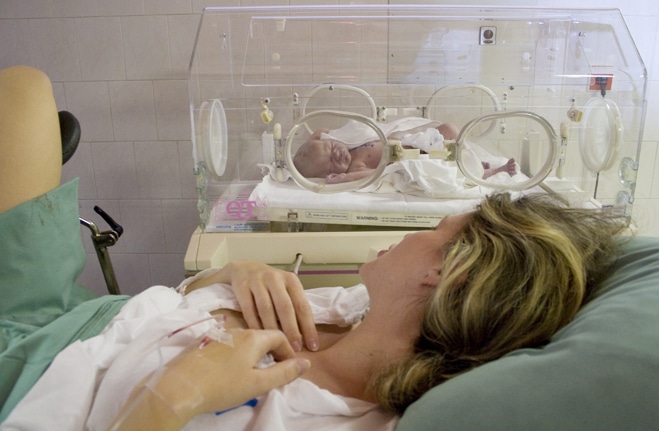Maternal care on the global stage and a closer look at hyponatraemia in the UK

As I was flicking through the pages of one of the latest issues of the British Medical Journal over my breakfast recently, I stumbled across an article comparing the quality of maternal healthcare across some of the richest countries in the world. I suppose it didn’t surprise me that, of these nations, the US was the most dangerous place to have a baby. However it did surprise me that the UK did not fare as well as I expected.
The study by the Commonwealth Fund reveals that in the US 17.4 women die in childbirth per 100,000 live births. In the UK the figure is 6.5.
The complete line up is as follows:
| Country | Maternal deaths per 100 000 live births |
|---|---|
| US | 17.4 |
| France | 8.7 |
| Canada | 8.6 |
| UK | 6.5 |
| Australia | 4.8 |
| Switzerland | 4.6 |
| Sweden | 4.3 |
| Germany | 3.2 |
| Netherlands | 3 |
| Norway | 1.8 |
| New Zealand | 1.7 |
The BMJ article, ‘US lags behind other rich nations in maternal healthcare’ highlighted a number of factors that may contribute to the high mortality rate in the US, including:
- A lack of universal healthcare (a woman’s access to healthcare may vary enormously across different states and depending on her insurance);
- Less involvement by midwives (in the US the supply of midwives is so low that many women cannot find one); and
- Inadequate postpartum care (more than half of pregnancy related deaths in the US occur after delivery and yet the US is alone in not guaranteeing a least one visit by a nurse or midwife within a week of birth).
This article made me reflect on the situation in the UK, particularly following the introduction of the NHS Early Notification Scheme (ENS).
The Early Notification Scheme
The ENS is a national programme for the early reporting of babies born with a potential severe brain injury following delivery at term, with the ultimate aim of driving up the quality of maternal and neonatal care.
The most recent ENS progress report highlights a number of issues that regularly impact on maternal and neonatal outcomes, such as a delay in delivering babies showing heart rate abnormalities. But the report did reveal one emerging and unexpected theme: the surprising impact that hyponatraemia (low sodium) is having on mothers and babies alike.
What is Hyponatraemia?
Hyponatraemia describes low blood sodium levels which can occur when a person takes on more fluid of low sodium content than they can excrete, leading to dilution of the blood and a fall in sodium concentration.
Women in labour are particularly vulnerable to hyponatraemia and this is thought to be due to an impaired ability to excrete water in the third trimester; exposure to the anti-diuretic effect of the hormone oxytocin which is responsible for uterine contractions; and the administration of large volumes of fluids used to deliver drugs that are used in the induction of labour.
Hyponatraemia in a mother can cause hyponatraemia in her unborn baby, severe cases of which can result in swelling of the brain with life-threatening consequences.
The ENS report highlights a dearth of research and national guidance in the area of hyponatraemia.
Northern Ireland – ahead of the curve
One region that seems to be ahead of the rest of the UK in the management of hyponatraemia is Northern Ireland, where the Regulation and Quality Improvement Authority (RQIA) published guidance on managing hyponatraemia in labour back in March 2017. The ENS report highlights that this guidance is useful for birth settings elsewhere in the UK.
How should hyponatraemia be managed?
According to the RQIA guidelines, the early signs and symptoms of hyponatraemia include nausea, lethargy and headache. It strikes me that these are relatively non specific – I imagine many women experience these symptoms in labour. More advanced signs include feelings of disorientation, slower reflexes, and in more extreme cases seizures and coma.
The management of hyponatremia is centred on careful and diligent fluid monitoring; the simple measurement of what goes in and what comes out. The guidelines state that women should have their oral intake recorded at least four hourly and should be encouraged to urinate two to four times hourly. Urine output should also be measured.
For women who are at greater risk of developing hyponatraemia, sodium monitoring is also crucial. Women with low sodium levels should have their fluid levels restricted and birth should be expedited. In women with severe symptoms of hyponatraemia, salty fluid should be administered intravenously.
Are cases of hyponatraemia on the rise?
It would appear from the ENS report that cases of hyponatraemia are increasing although it is not known whether this is actually the case, or whether hyponatraemia has just been under-recognised for a while.
One factor that may be influencing a possible increase in cases is thought to include the impact of ‘healthy living’ and the promotion of drinking plenty of water.
Whether cases of hyponatraemia are on the rise or not, one thing that is certain in the report is that further research is required to understand the cause of hyponatraemia and develop clearer guidelines for the management of this potentially life threatening condition.
Our experience of hyponatraemia
At RWK Goodman, we work with children who have suffered from a brain injury around the time of their birth. For many of these children, conditions such as hyponatraemia have complicated their first few days of life. It saddens me to think that cases of hyponatraemia are on the rise in the UK but I am encouraged by the determination of the ENS to promote research and develop guidance on this condition.